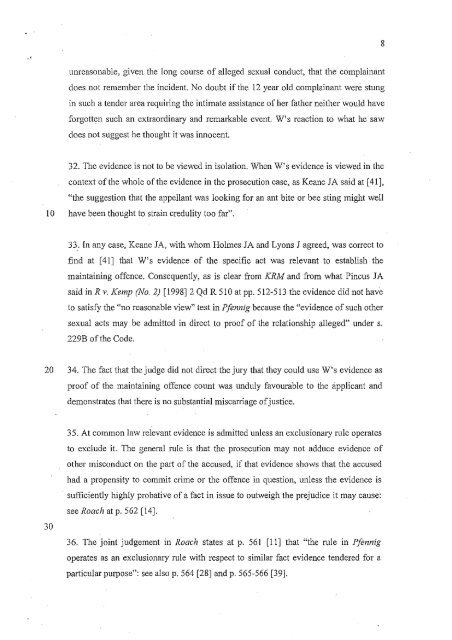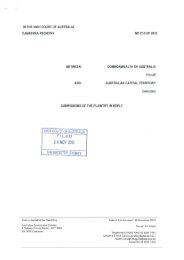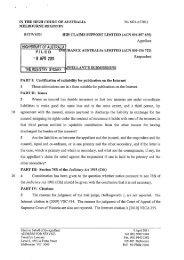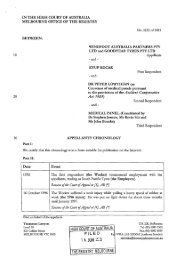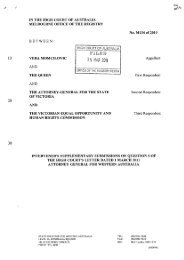Written submissions - High Court of Australia
Written submissions - High Court of Australia
Written submissions - High Court of Australia
You also want an ePaper? Increase the reach of your titles
YUMPU automatically turns print PDFs into web optimized ePapers that Google loves.
.'<br />
8<br />
unreasonable, given the long course <strong>of</strong> alleged sexual conduct, that the complainant<br />
does not remember the incident No doubt if the 12 year old complainant were stung<br />
in such a tender area requiring the intimate assistance <strong>of</strong> her father neither would have<br />
forgotten such an extraordinary and remarkable event W's reaction to what he saw<br />
does not suggest he thought it was innocent<br />
32. The evidence is not to be viewed in isolation. When W's evidence is viewed in the<br />
context <strong>of</strong> the whole <strong>of</strong> the evidence in the prosecution case, as Keane JA said at [41],<br />
"the suggestion that the appellant was looking for an ant bite or bee sting might well<br />
10 have been thought to strain credulity too far".<br />
33. In any case, Keane JA, with whom Holmes JA and Lyons J agreed, was correct to<br />
find at [41] that W's evidence <strong>of</strong> the specific act was relevant to establish the<br />
maintaining <strong>of</strong>fence. Consequently, as is clear from KRM and from what Pincus JA<br />
said in Rv. Kemp (No. 2) [1998]2 Qd R 510 at pp. 512-513 the evidence did not have<br />
to satisfy the "no reasonable view" test in Pfennig because the "evidence <strong>of</strong> such other<br />
sexual acts may be admitted in direct to pro<strong>of</strong> <strong>of</strong> the relationship alleged" under s.<br />
229B <strong>of</strong> the Code.<br />
20 34. The fact that the judge did not direct the jury that they could use W's evidence as<br />
pro<strong>of</strong> <strong>of</strong> the maintaining <strong>of</strong>fence count was unduly favourable to the applicant and<br />
demonstrates that there is no substantial miscarriage <strong>of</strong> justice.<br />
30<br />
35. At common law relevant evidence is admitted unless an exclusionary rule operates<br />
to exclude it The general rule is that the prosecution may not adduce evidence <strong>of</strong><br />
other misconduct on the part <strong>of</strong> the accused, if that evidence shows that the accused<br />
had a propensity to commit crime or the <strong>of</strong>fence in question, unless the evidence is<br />
sufficiently highly probative <strong>of</strong> a fact in issue to outweigh the prejudice it may cause:<br />
see Roach at p. 562 [14].<br />
36. The joint judgement in Roach states at p. 561 [11] that "the rule in Pfennig<br />
operates as an exclusionary rule with respect to similar fact evidence tendered for a<br />
particular purpose": see also p. 564 [28] and p. 565-566 [39].


